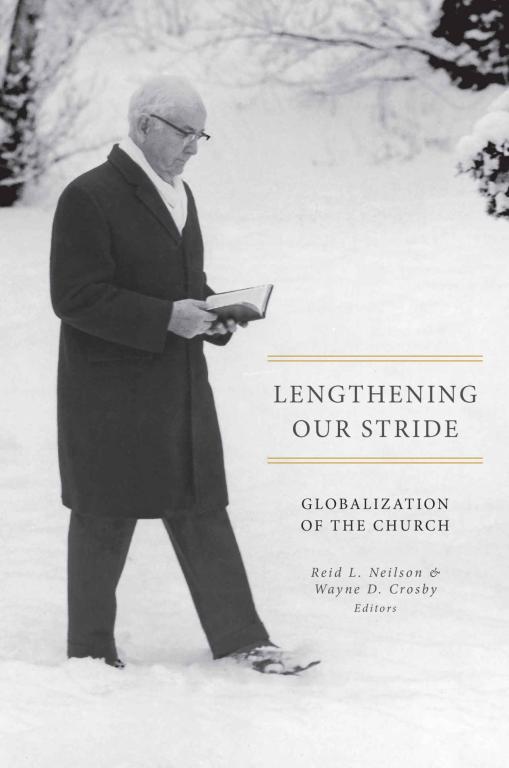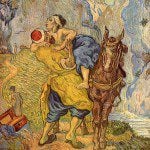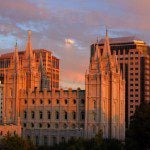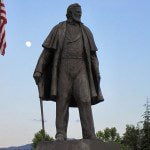
This is probably my favorite image of President Spencer W. Kimball, for whom I developed very great affection during his tenure as President of the Church of Jesus Christ of Latter-day Saints.
***
During a relatively recent conversation, the question of modern revelation came up. At one point, the discussion turned to the 1978 revelation on priesthood that was received by President Spencer W. Kimball in conjunction with his two counselors and almost all of the then Quorum of the Twelve Apostles. And that reminded me of (among other things) the two relevant recollections that I share here below.
The first comes from Elder David B. Haight (1906-2004), who was a member of the Quorum of the Twelve in 1978:
I would hope someday that our great-grandson Mark and others of our posterity would have similar spiritual experiences and that they would feel the spiritual power and influence of this gospel. I hope that Mark and others will have opportunities such as I had when I was in the temple when President Spencer W. Kimball received the revelation regarding the priesthood. I was the junior member of the Quorum of the Twelve. I was there. I was there with the outpouring of the Spirit in that room so strong that none of us could speak afterwards. We just left quietly to go back to the office. No one could say anything because of the powerful outpouring of the heavenly spiritual experience.
But just a few hours after the announcement was made to the press, I was assigned to attend a stake conference in Detroit, Michigan. When my plane landed in Chicago, I noticed an edition of the Chicago Tribune on the newsstand. The headline in the paper said, “Mormons Give Blacks Priesthood.” And the subheading said, “President Kimball Claims to Have Received a Revelation.” I bought a copy of the newspaper. I stared at one word in that subheading—claims. It stood out to me just like it was in red neon. As I walked along the hallway to make my plane connection, I thought, Here I am now in Chicago walking through this busy airport, yet I was a witness to this revelation. I was there. I witnessed it. I felt that heavenly influence. I was part of it. Little did the editor of that newspaper realize the truth of that revelation when he wrote, “… Claims to Have Received a Revelation.” Little did he know, or the printer, or the man who put the ink on the press, or the one who delivered the newspaper—little did any of them know that it was truly a revelation from God. Little did they know what I knew because I was a witness to it. (“This Work Is True,” April 1996 general conference, italics in the original)
And here are a pair of quotations about the 1978 revelation on priesthood from Adventures of a Church Historian, the memoirs of the late Dr. Leonard J. Arrington, who is often (justly) considered the father of modern professional Latter-day Saint historiography:
“Those in attendance said that as he began his earnest prayer, they suddenly realized that it was not Kimball’s prayer, but the Lord speaking through him. A revelation was being declared. Kimball himself realized that the words were not his but the Lord’s. During that prayer some of the Twelve—at least two who have said so publicly—were transported into a celestial atmosphere, saw a divine presence and the figures of former presidents of the church . . . smiling to indicate their approval and sanction. Others acknowledged the voice of the Lord coming, as with the prophet Elijah, ‘through the still, small voice.’ The voice of the Spirit followed their earnest search for wisdom and understanding.
“At the end of the heavenly manifestation, Kimball, weeping for joy, confronted the [other members of the First Presidency and the Council of the Twelve], many of them also sobbing, and asked if they sustained this heavenly instruction. Embracing, all nodded vigorously and jubilantly their sanction. There had been a startling and commanding revelation from God—an ineffable experience.
“Two of the apostles present described the experience as a ‘day of Pentecost’ similar to the one in the Kirtland Temple on April 6, 1836, the day of its dedication. They saw a heavenly personage and heard heavenly music. To the temple-clothed members, the gathering, incredible and without compare, was the greatest singular event of their lives. Those I talked with wept as they spoke of it. All were certain they had witnessed a revelation from God.”[1]
He went on to say that
“It is a common regret among Latter-day Saints that general authorities do not speak openly about their remarkable spiritual experiences in the way Joseph Smith and other early prophets used to do. Although they unquestionably do have such experiences, they have said little about this one.”[2]
Professor Arrington, who was himself a committed and believing member of the Church of Jesus Christ of Latter-day Saints, termed this revelation “indisputable evidence of God’s presence and direction in these latter days—divine reaffirmation of the faith and values of our church.”[3]
[1] Leonard J. Arrington, Adventures of a Church Historian (Urbana and Chicago: University of Illinois, 1998), 177. On the preceding page, Professor Arrington remarks that “As a historian I sought to learn the particulars and record them in my private diary. The following account is based on dozens of interviews with persons who talked with church officials after the revelation was announced. Although members of the Twelve and the First Presidency with whom I sought interviews felt they should not elaborate on what happened, I learned details from family members and friends to whom they had made comments.” He acknowledges that “Some of these statements may have involved colorful, symbolic language that was taken literally.” Arrington’s entire chapter on the subject, “The Long-Promised Day,” pp. 175-185, is of interest.
[2] Arrington, Adventures of a Church Historian, 176 (emphasis in the original).
[3] Arrington, Adventures of a Church Historian, 176.
The truth or falsity of the claims of the Restoration doesn’t depend solely upon Joseph Smith. There are and have been many others — his contemporaries and our contemporaries and everywhere in between — who also bear witness.












